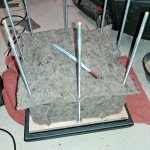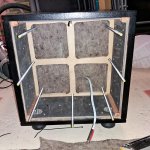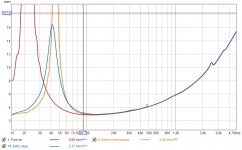I don't feel that way at all! That wave front from an open baffle is coming back to haunt you too! And it doesn't even have to go through the cone.
I'm pretty sure most OB fanatics actually like that delayed back wave, after it hit the wall behind the speakers. It is part of the total experience.
... with OB speakers. ...Take them outside or absorb that back-wave and I'm pretty sure they will start to resemble the sound of a good behaving closed box.
A bold thing to say huh?
But just measure at ear positions to "see" what I'm talking about. It is the reason for my mid-side EQ adventure (and many more experiments).
There isn't much we can't measure, there still is a lot to learn too. Like how to interpret the measurements and know what we "hear" into that.
Chances are that people that claim too much damping "kills the sound" actually like what they get back through the cone (messing up the frequency response). ...
Your wish to compare the back-wave from an OB to a back-wave from inside a speaker box is not helpful. Only one of those two events is going to be perceived as aural degeneration, and the other as aural enhancement. The extra delay for an OB back-wave to arrive at the ear moves it into a desirable enhancement of the direct sound alone. No comparison.
Your next paragraph about taking OB outside and they sound like a wannabe 'good' box speaker, is also full of holes. Firstly, it is the box speaker which excites more room activity, and more inconsistently, so it is actually the box which is going to change sound more when taken outside. Secondly, it is the box speaker's sound that is 'resembling' towards the OB sound outdoors as the internal damping gets higher, not the OB 'resembling' towards the box sound. Thirdly, and most importantly of all, taking them outside, which you posit as a great way to isolate the speaker from the room, actually destroys their ability to meet human needs as music reproducers, and presumes you think that the room is a problem that can be validly eliminated that way, and needs to be so handled to learn more about the speaker's performance, even as an academic exercise. This is all wrong-headed.
As Toole has written, "separating sound sources from the spaces they are in is something humans do routinely." There is no need for your outdoor experiment to achieve that separation, for the mind has already done it. All that you achieve by going outdoors or absorbing the back wave is killing the sound of crucial naturalness. A favoured reference of Toole's in this regard is E.T. Canby, who wrote in 1951, "....the compound effect of multiple room reflections upon played music, is—if you wish—a distortion of “pure” music; but it happens to be a distortion essential to naturalness of sound. Without it, music is most graphically described as “dead.” Liveness fertilizes musical performance, seasons and blends and rounds out the sound, assembles the raw materials of overtone and fundamental into that somewhat blurred and softened actuality that is normal, in its varying degrees, for all music."
So, IMO it is not so 'bold' to claim the two speakers will sound similar outdoors, as irrelevant. And quite misleading, as is your claim that it is only fanatics of a certain ilk who will prefer liveness off the front wall. I can't think of an unbiased reason why you would even head the conversation down that path.
...John Dunlavy. He had that approach of being instrumental on measuring and making them as perfect as he could by measuring. Then he would start that long process of listening tests that would end up with products that measure perfectly and also have that magic to them....
Just as a gently humourous aside, you seem to be claiming that, Dunlavy could make a speaker measure perfect, then make changes, and still it measures perfect.
cheers
I guess you have OB speakers? 
You've missed my point completely and even seem to feel attacked by it. This was not my message at all, and you've read things in it that I did not mean to say.
All I am saying that a boxed speaker does not have to sound like a box, but there is more than one reason it could sound that way.
Firstly, the inner wave bouncing back inside the sealed speaker should be dealt with properly. This starts with impedance measurements and requires work. In that case if you bring both an OB and that good sealed speaker outside, the differences will be way less or even negligible.
Second, I've never said people of a certain ilk like OB. I know for a fact that many people like a level of (diffused) reflections and I pointed out the advantages OB speakers have in that regard when compared to boxed/sealed speakers. That delayed wave front will indeed hide some of the cross talk effect that's inherently present in stereo reproduction.
With a sealed speaker you'd have less of that kind of back wave it and chances are it will be less balanced when compared to the direct sound.
There is a third reason as you bring it up, but even that should not be a dealbreaker for sealed if you know the reason why. Read my plots is all I'll say about that one.
So don't read things into it, as said, I'm not judging anyone for his/her preference. You must not have read my journey, else you'd know I add virtual reflections (diffused, and as scottjoplin already mentioned, the OB back wave should be diffused too, ideally).
What's with the resemblance remark though, I can't say an OB will resemble a good boxed/sealed speaker but should mention it the other way around?
Talk about a bias....
The only reason for me to state this is to get people to think! People that follow my thread already know what crazy experiments I do. They should know that I look at other speakers to, and ask myself the question: why do people like it so much? To learn I may add, not to judge them.
So please don't make anything of it that wasn't intended here and let people with other preferences than yourself have their spot as well, none of the speaker types are "better" or a "more valuable" concept than any other solutions.
It isn't true that a sealed speaker should sound like a box. That message I would like to get across. But there are reasons people seem to think they do.
If you don't like (to read) my thoughts, fine. Stop reading them. But do not misinterpret what I'm saying, you don't know me well enough. I did not attack anyone for their choice and wouldn't even do that. Yes, I have had and heard OB speakers in my past. There is a reason why I don't have them now, and it's not because I did not like them or the sound they made. My choice is all about space management.
I hope I never defend my choices like this. People seem to get hung up on their own concept as being the holy grail and nothing else may (is allowed to) even come close.
That stops a person from thinking. Being open minded and staying that way. Heck I know for a fact that I am guilty of that on more than a few accounts but at least I try real hard to stay away from it. So even here I do not mean to attack, just try and mellow down a bit and read the message without reading into it. What exactly was said and why? The only reason: to learn from each other. To learn why something is that good for a large group of people.
I've spend even more time reading up on other concepts than I've spend on my speakers. And people that have been following me know how much time I've spend on them .
.
You've missed my point completely and even seem to feel attacked by it. This was not my message at all, and you've read things in it that I did not mean to say.
All I am saying that a boxed speaker does not have to sound like a box, but there is more than one reason it could sound that way.
Firstly, the inner wave bouncing back inside the sealed speaker should be dealt with properly. This starts with impedance measurements and requires work. In that case if you bring both an OB and that good sealed speaker outside, the differences will be way less or even negligible.
Second, I've never said people of a certain ilk like OB. I know for a fact that many people like a level of (diffused) reflections and I pointed out the advantages OB speakers have in that regard when compared to boxed/sealed speakers. That delayed wave front will indeed hide some of the cross talk effect that's inherently present in stereo reproduction.
With a sealed speaker you'd have less of that kind of back wave it and chances are it will be less balanced when compared to the direct sound.
There is a third reason as you bring it up, but even that should not be a dealbreaker for sealed if you know the reason why. Read my plots is all I'll say about that one.
So don't read things into it, as said, I'm not judging anyone for his/her preference. You must not have read my journey, else you'd know I add virtual reflections (diffused, and as scottjoplin already mentioned, the OB back wave should be diffused too, ideally).
What's with the resemblance remark though, I can't say an OB will resemble a good boxed/sealed speaker but should mention it the other way around?
Talk about a bias....
The only reason for me to state this is to get people to think! People that follow my thread already know what crazy experiments I do. They should know that I look at other speakers to, and ask myself the question: why do people like it so much? To learn I may add, not to judge them.
So please don't make anything of it that wasn't intended here and let people with other preferences than yourself have their spot as well, none of the speaker types are "better" or a "more valuable" concept than any other solutions.

It isn't true that a sealed speaker should sound like a box. That message I would like to get across. But there are reasons people seem to think they do.
If you don't like (to read) my thoughts, fine. Stop reading them. But do not misinterpret what I'm saying, you don't know me well enough. I did not attack anyone for their choice and wouldn't even do that. Yes, I have had and heard OB speakers in my past. There is a reason why I don't have them now, and it's not because I did not like them or the sound they made. My choice is all about space management.
I hope I never defend my choices like this. People seem to get hung up on their own concept as being the holy grail and nothing else may (is allowed to) even come close.
That stops a person from thinking. Being open minded and staying that way. Heck I know for a fact that I am guilty of that on more than a few accounts but at least I try real hard to stay away from it. So even here I do not mean to attack, just try and mellow down a bit and read the message without reading into it. What exactly was said and why? The only reason: to learn from each other. To learn why something is that good for a large group of people.
I've spend even more time reading up on other concepts than I've spend on my speakers. And people that have been following me know how much time I've spend on them
Last edited:
Regards things Toole wrote (especially him since he is referenced and quoted the most) his main interest was correlating measurements with psychoacoustics through studying perceptions of groups of people, in other words trying to find the commonalities. This is why his books are often used as references in the business as a how to guide for many aspects of sound production and reproduction. Inevitably elements of personal preference creep in at all levels, this should to be taken into account and allowed for. All IMHO of course and I edited out a lot of my waffle because I wanted to be as objective as I could considering....................
I left Toole out of it, as what he states is true, up to an extend. As I've said earlier in this thread, you can actually train/learn to listen to your room, the start of that isn't even complicated. But when doing so it does become much harder to unlearn it. It might spoil the fun and it could be wise to just listen with the auto room correction brain part doing its job.
I did not imagine that anyone would read I was comparing the backwave of OB with a backwave from inside the sealed speaker. Someone has been reading half the story. I see quite a few more holes and a lack of understanding of what this thread is about (mainly arrays right? And how they can work with the room). anyway, back to the regular scheduled program.
I did not imagine that anyone would read I was comparing the backwave of OB with a backwave from inside the sealed speaker. Someone has been reading half the story. I see quite a few more holes and a lack of understanding of what this thread is about (mainly arrays right? And how they can work with the room). anyway, back to the regular scheduled program.
Last edited:
.... I did not imagine that anyone would read I was comparing the backwave of OB with a backwave from inside the sealed speaker.......
me too... certainly I never read that you were comparing backwave of OB with backwave from inside sealed speaker
Just as a gently humourous aside, you seem to be claiming that, Dunlavy could make a speaker measure perfect, then make changes, and still it measures perfect.Curious indeed.
cheers
I don´t claim anything ... I am referring to what late Dunlavy´s approach was according to Dunlavy himself. These are totally different things
Last edited:
Don't feel bad. Tnarg made snide, snippy comments on at least one other forum last night
No worries mate.... he probably had too much from Booze Brothers
Not sure where in Australia he is located though, Booze brothers are only in South Australia
Last edited:
Don't feel bad. Tnarg made snide, snippy comments on at least one other forum last night
I think I may have read what you speak of. I liked what was said in reply to him. It does resemble my feelings about it all.
There are a lot of different paths that can lead to satisfying sound. It's what they (the concepts) share that is really interesting to me. But also how they differ from each other and what that does, as there's something to learn from that too, I believe that would be true for (almost) all of us. I haven't found any uncompromised solution covering everything of interest yet.
But I'm pretty sure if you learn more about this game you can actually improve bits and pieces of it. No matter what concept you start with, and a good start would be to look at the other concepts available and see what those are about and why.
Dunlavy has been quite open about his vision on all subjects concerning and different facets of audio. I've been able to trace a lot of his views on the net, including lots of old posts of his on forums/message boards long gone. It has been quite inspirational to say the least. I can recommend it to anyone even slightly interested to read up what he had to say.
Not much time to write this down so I'll try and make it quick...
Stuffing the subwoofer enclosure, first I've build a wool felt cage around the driver:

Next I filled that space with fiberglass insulation wool:

The other side of the brace was filled with the itchy fiberglass alone:

So what did this do? Let's see the impedance measurements:

Easy to see things have changed a lot. The impedance peak has been reduced and moved to the left. Not quite as much as I hoped for, but we have to remember this driver is new, unused and will come down a few Hz after proper break in. The stuffing was quite successful to lower the peak value and there's still quite a gain in 'virtual volume increase' noticeable.
I wanted to try one other thing, instead of packing the fiberglass fill more tight I decided to try adding a couple of real wool felt layers.
So I put in 3 extra layers of wool felt in between the fiberglass fill at the non driver side.

Between each layer of fiberglass there's a layer of wool felt, about 7mm thickness. So it won't compress the fiberglass, instead it will just be a dissimilar material for the sound wave to travel trough.

Let's see what it did to the impedance:

As seen the impedance peak is brought down even further. The curve is ever so slightly more smooth as well. I can live with this combination as a final result. I could go on and on, but that wasn't the goal. The goal was to reduce the peak, make the curve smooth and move the peak lower in frequency. Job done I'd say. Break in will probably have a further effect, so I'll first build up the second sub as this one and continue with installing the amps and seal off the enclosures.
One more plot in detailed mode comparing driver in enclosure vs fully stuffed:

Stuffing the subwoofer enclosure, first I've build a wool felt cage around the driver:
Next I filled that space with fiberglass insulation wool:
The other side of the brace was filled with the itchy fiberglass alone:
So what did this do? Let's see the impedance measurements:
Easy to see things have changed a lot. The impedance peak has been reduced and moved to the left. Not quite as much as I hoped for, but we have to remember this driver is new, unused and will come down a few Hz after proper break in. The stuffing was quite successful to lower the peak value and there's still quite a gain in 'virtual volume increase' noticeable.
I wanted to try one other thing, instead of packing the fiberglass fill more tight I decided to try adding a couple of real wool felt layers.
So I put in 3 extra layers of wool felt in between the fiberglass fill at the non driver side.
Between each layer of fiberglass there's a layer of wool felt, about 7mm thickness. So it won't compress the fiberglass, instead it will just be a dissimilar material for the sound wave to travel trough.
Let's see what it did to the impedance:
As seen the impedance peak is brought down even further. The curve is ever so slightly more smooth as well. I can live with this combination as a final result. I could go on and on, but that wasn't the goal. The goal was to reduce the peak, make the curve smooth and move the peak lower in frequency. Job done I'd say. Break in will probably have a further effect, so I'll first build up the second sub as this one and continue with installing the amps and seal off the enclosures.
One more plot in detailed mode comparing driver in enclosure vs fully stuffed:
Attachments
-
 woolcage.jpg279 KB · Views: 300
woolcage.jpg279 KB · Views: 300 -
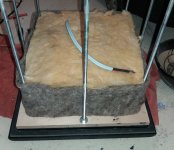 cage filled.jpg214.9 KB · Views: 309
cage filled.jpg214.9 KB · Views: 309 -
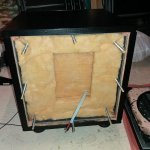 other side packed.jpg219.5 KB · Views: 305
other side packed.jpg219.5 KB · Views: 305 -
 wool layers.jpg252 KB · Views: 309
wool layers.jpg252 KB · Views: 309 -
 fully stuffed.jpg232 KB · Views: 303
fully stuffed.jpg232 KB · Views: 303 -
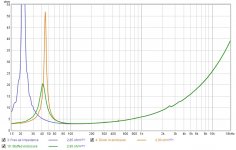 free-enclosure-stuffed.jpg104.7 KB · Views: 612
free-enclosure-stuffed.jpg104.7 KB · Views: 612 -
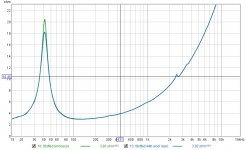 stuffed wool.jpg101.4 KB · Views: 302
stuffed wool.jpg101.4 KB · Views: 302 -
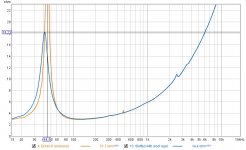 detail compare.jpg103.3 KB · Views: 304
detail compare.jpg103.3 KB · Views: 304
Don't feel bad. Tnarg made snide, snippy comments on at least one other forum last night
The only snide or snippy comment around here is yours, above. Poor show my friend.
Cat protector is on...
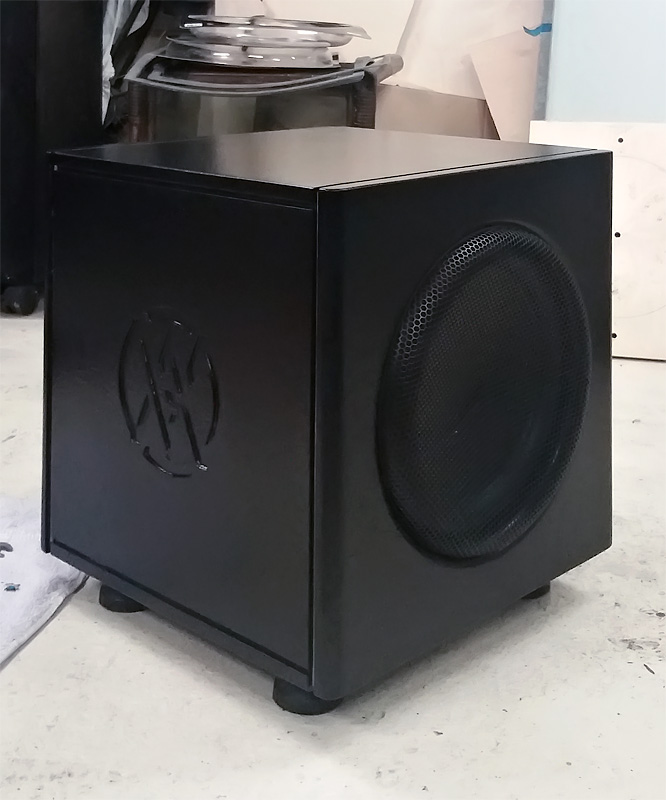
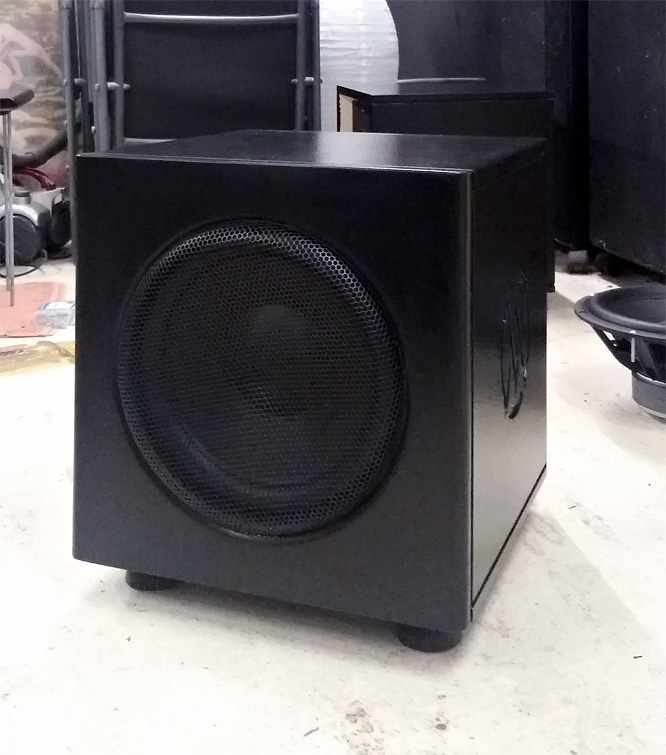
I had to cut a groove to fit it (original hole was 280mm, protector was ~290mm).
I used the router table and covered the surface of the table with a towel to protect the paint. Worked like a charm. I glued the protector in place (Bison Polymax, a rubbery glue) and also used small nails to make sure it will stay there. Space between dustcap and the grille is just over 25mm to cover x-mech (not x-max) distance. The screen is bent inwards in the middle, the surrounds have plenty of room to move.
Not as pretty as seeing the naked driver but it will do. This Rockford Fosgate protection screen was the most open screen I could find.
Very nice!
The Norwegian guy's system earlier pointed to in this thread ... He claims he gets way more of the the Vifa TG9 equipped linesources when he is not running them full-range. In his case, it's claimed that removing the low bass from the fullranges takes them significantly up a notch in many levels ... an it's claimed that is not subtle at all.
@halair listened to those and he may possibly shed some more light onto this
I have never been able to a/b test this but I assume this should be pretty easy to verify with measurements too...
Just a thought
It think you will find the same outcome...
NICE WORK

Merry christmas guys
It think you will find the same outcome...
Merry christmas guys
You guys should know me better by now. I couldn't stop wondering if I could make a chance for the better. So after another disassembly, I put an extra layer of felt around the cage I've build for the driver and topped it off with another layer of felt:

The first half is neatly stuffed this way:

After that I put in another layer of fiberglass stuffing as one of the wool felt layers was used to close the wool felt covered and stuffed cage.
I ran an impedance plot: it was moving towards overstuffed, not bringing the peak more to the left, while still bringing it down.
Out with one layer of fiberglass fill again. I had to satisfy my curiosity.
The peak is damped even more than before, and traces of the last wiggles I saw were suppressed far enough to satisfy even me. The impedance peak did not move further down in frequency, but it is damped a little more.

This will end my madness... I've booked about a 20% gain lowering the peak frequency. After break in the peak will probably come down ever so slightly (about 2-3 Hz). Making the Q value about ~0.77 right now despite the small enclosure. The enclosure size was aimed to get me about 0.70 after damping but at that time I had not planned on putting the amplifier inside the enclosure. I will settle for this, EQ will shape the rest as that was planned from the start. After break in I could actually be very close to the planned Q.
Main importance is I managed to get a good clean impedance curve, free of strange wiggles (even though it was hard to get a good reading with lots of ambient/street noise).
On with the second sub... before family events take over...
The first half is neatly stuffed this way:
After that I put in another layer of fiberglass stuffing as one of the wool felt layers was used to close the wool felt covered and stuffed cage.
I ran an impedance plot: it was moving towards overstuffed, not bringing the peak more to the left, while still bringing it down.
Out with one layer of fiberglass fill again. I had to satisfy my curiosity.
The peak is damped even more than before, and traces of the last wiggles I saw were suppressed far enough to satisfy even me. The impedance peak did not move further down in frequency, but it is damped a little more.
This will end my madness... I've booked about a 20% gain lowering the peak frequency. After break in the peak will probably come down ever so slightly (about 2-3 Hz). Making the Q value about ~0.77 right now despite the small enclosure. The enclosure size was aimed to get me about 0.70 after damping but at that time I had not planned on putting the amplifier inside the enclosure. I will settle for this, EQ will shape the rest as that was planned from the start. After break in I could actually be very close to the planned Q.
Main importance is I managed to get a good clean impedance curve, free of strange wiggles (even though it was hard to get a good reading with lots of ambient/street noise).
On with the second sub... before family events take over...
Attachments
Best cat protector is scaring the bajesus out of them with the speaker!
Tried and true method that has succeeded for 4 decades now it to have speakers setup first time cat sees them. Prior to first exposure set high level radio static eg white noise at near max spl.
Mute
Let cat into room and have finger on the trigger ehhh unmute lol
At first stretch upon said speaker just as its about to reach up with claws extended release the Kracken!
You may need a ladder to declaw them from the ceiling. Will take a W I D E birth around them in from then on.
Works a Peach
Tried and true method that has succeeded for 4 decades now it to have speakers setup first time cat sees them. Prior to first exposure set high level radio static eg white noise at near max spl.
Mute
Let cat into room and have finger on the trigger ehhh unmute lol
At first stretch upon said speaker just as its about to reach up with claws extended release the Kracken!
You may need a ladder to declaw them from the ceiling. Will take a W I D E birth around them in from then on.
Works a Peach
Best cat protector is scaring the bajesus out of them with the speaker!
Tried and true method that has succeeded for 4 decades now it to have speakers setup first time cat sees them. Prior to first exposure set high level radio static eg white noise at near max spl.
Mute
Let cat into room and have finger on the trigger ehhh unmute lol
At first stretch upon said speaker just as its about to reach up with claws extended release the Kracken!
You may need a ladder to declaw them from the ceiling. Will take a W I D E birth around them in from then on.
Works a Peach
That's harsh lol.
- Home
- Loudspeakers
- Full Range
- The making of: The Two Towers (a 25 driver Full Range line array)
